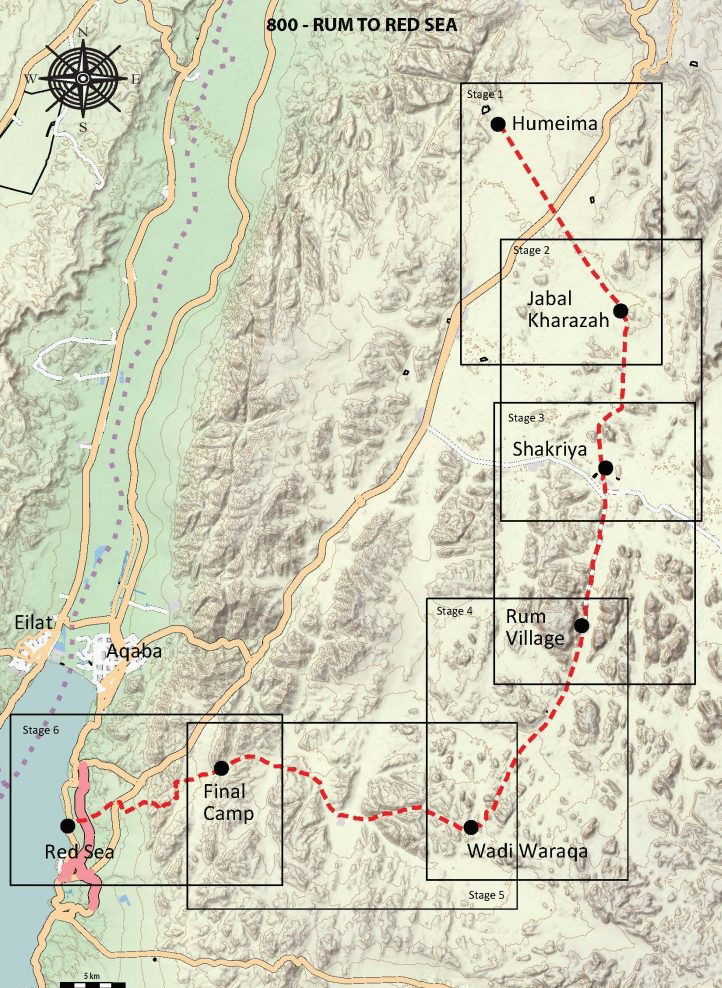RUM TO RED SEA
Heading south down Wadi Rum, the trail passes beneath the towering cliffs of Jebel Rum and Jebel Um Ishrin through the region described by T E Lawrence as “Rum the magnificent, vast, echoing, and godlike.”
It passes between the cliffs of Jebel Khazali and their ancient rock art and crosses Jebel Qattar with its concealed “dripping spring,” still winding between the unique and colorful backdrops of Wadi Rum’s sandstone desert mountains. Turning west again, the trail leaves Jebel al Qiddar and its wadi to head west down Wadi Waraaqa, passing a number of cisterns dotting the route to the Bedouin village of Titen.
From Titen, the trail follows old shepherd paths, weaving its way west across desert wadis and over granite mountains striated with basalt dyke intrusions. At the last pass, hikers suddenly gain their first view of the Red Sea and the Gulf of Aqaba, beyond which are the mountains of Sinai. The descent from the pass leads down to long sandy wadis reaching all the way to the welcoming and warm waters of the Red Sea – the end of the Jordan Trail – between the border with Saudi Arabia and the port of Aqaba.
Days: 6
Length: 112 km
Main sites in the Rum to Red Sea Region:
- Wadi Rum (World Heritage site)
- Wadi Rum Bedouin village
- Lawrence’s Spring (Ain Shellaleh) and the Nabataean Temple
- Dramatic desert scenery – sandstone domes and granite and basalt striated mountains, changing color constantly throughout the day
- Bedouin encampments
- Village of Titen
- Red Sea
- Aqaba Red Sea Resort
ACCOMMODATIONS
Aqaba is a large tourist town and has plenty of hotels. The wilds of Wadi Rum are also full of tourist camps, which usually operate by picking up visitors at the Visitors’ Center and taking them to camp via a scenic jeep ride. Self-supported hikers are still generally an unknown breed; but if you hike into one of these camps, you may be able to stay the night there if there is room or even pay for transport to another camp. In both Aqaba and Wadi Rum, of course, overnight options vary widely in terms of cost, level of luxury, and quality.
Rum Village also has the Rest House, a small restaurant which offers tent camping in its backyard for 2JD for using your own tent and 3JD for using one of theirs. This price includes a shower, which may or may not have hot water.
Unless you make a detour off-trail to stay in one of Wadi Rum’s tourist camps, there are no accommodations in this region – wild camping is the way to go.
DAY 1: HUMEIMA TO JABAL KHARAZEH
- Distance: 19 km
- Time: 6 hours
- Physical Challenge: Moderate
- Trail Difficulty: Moderate
- Waymarked: No
DAY 2: JABAL KHARAZEH TO SHAKRIYA
- Distance: 16 km
- Time: 6 hours
- Physical Challenge: Moderate
- Trail Difficulty: Moderate
- Waymarked: No
DAY 3: SHAKRIYA TO RUM VILLAGE
- Distance: 12.1 km
- Time: 3-4 hours
- Physical Challenge: Easy
- Trail Difficulty: Easy
- Waymarked: No
DAY 4: RUM VILLAGE TO WADI WARAQA
- Distance: 20.6 km
- Time: 5-7 hours
- Physical Challenge: Moderate
- Trail Difficulty: Moderate
- Waymarked: No
DAY 5: WADI WARAQA TO FINAL CAMP
- Distance: 25.9 km
- Time: 7-9 hours
- Physical Challenge: Moderate
- Trail Difficulty: Moderate
- Waymarked: No
DAY 6: FINAL CAMP TO AQABA
- Distance: 18.4 km
- Time: 5-7 hours
- Physical Challenge: Difficult
- Trail Difficulty: Difficult
- Waymarked: No



